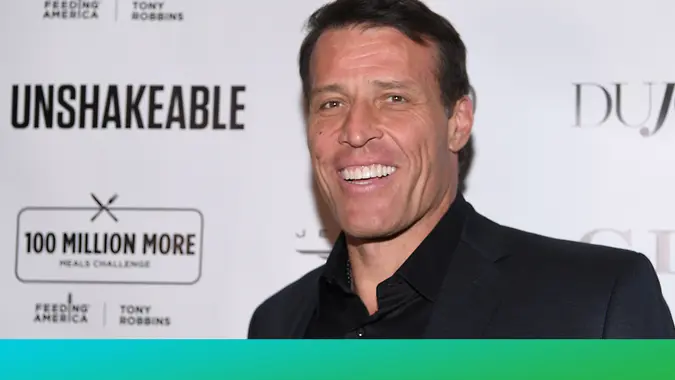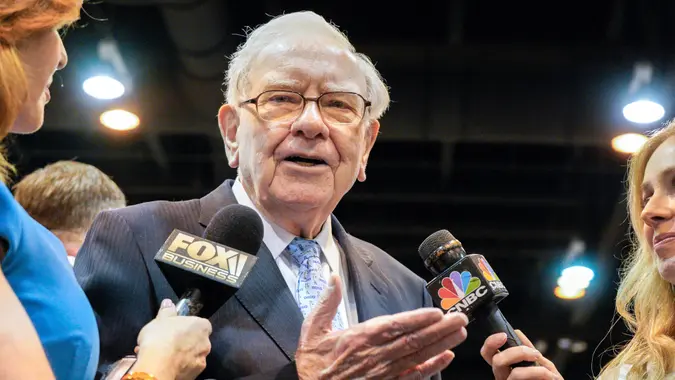5 Investors Who Invest Like Warren Buffett and What You Can Learn

Commitment to Our Readers
GOBankingRates' editorial team is committed to bringing you unbiased reviews and information. We use data-driven methodologies to evaluate financial products and services - our reviews and ratings are not influenced by advertisers. You can read more about our editorial guidelines and our products and services review methodology.

20 Years
Helping You Live Richer

Reviewed
by Experts

Trusted by
Millions of Readers
Warren Buffett made headlines recently when he announced he will step down from his role as Chair of the Board of Berkshire Hathaway. The legendary investor is well known for bringing his successful style to the conglomerate and making himself — and a lot of other shareholders– exceedingly rich.
But Buffett is not the only investor who subscribes to the investment theories that made him rich.
Here are five investors who invest like Warren Buffett and what you can learn from them.
Benjamin Graham
Benjamin Graham was the original value investor, and he taught Buffett. Graham is considered to be the pioneer of modern securities analysis and made a fortune buying companies that were undervalued and holding them until the market caught up. Graham espoused the wisdom of technical analysis, and famously said, “To the extent that Wall Street gets away from book value, it is headed into potentially. Dangerous areas of thinking. It then introduces factors — chiefly the notion of increasing future earnings — which are very difficult to measure and which therefore may be badly measured.”
While you obviously cannot watch Graham invest today, as he died in 1976, his book, “The Intelligent Investor,” is required reading for any aspiring value investor.
Peter Lynch
Peter Lynch managed the Fidelity Magellan mutual fund from 1997 to 1990, averaging a 29.2% annual return over that time.
Lynch says the biggest mistake small investors make is that they cannot explain why they own a particular stock. In an address to the National Press Club in 1994, Lynch said, “The single most important thing to me in the stock market for anyone is to know what you own. I’m amazed how many people own stocks; they would not be able to tell you why they own it. They couldn’t say in a minute or less why they own it. Actually, if you really press them, they’ll say, ‘the reason is own this is the sucker is going up.'”
This philosophy mirrors one of Buffett’s most famous investing truisms, “buy what you know.”
Joel Greenblatt
Joel Greenblatt is managing partner and co-chief investment officer of Gotham Asset Management and a former professor at Columbia Business School, where he taught value investing.
In his book “The Little Book That Beats the Market,” Greenblatt outlines his stock-picking methodology. He looks at a company’s return on invested capital, or ROIC, to determine whether or not the company is efficiently generating earnings from its invested capital. He also looks at earnings yield, which is the amount of earnings generated for each dollar invested in the stock (so, the inverse of the P/E ratio).
Greenblatt evaluates every stock using these two metrics and chooses those with the highest combined ranking.
John Templeton
John Templeton established the Templeton Growth fund, which boasted an average growth rate of 15% over 38 years.
Templeton looked for stocks that were at their lowest point, which he referred to as “points of maximum pessimism.” This philosophy is in line with Buffett’s recommendation to “be fearful when others are greedy, and greedy when others are fearful.”
In 1939, when war broke out in Europe, Templeton bought stock in over 100 companies that were then selling for a dollar per share or less. He turned a profit on all but four of them. Money magazine called him “arguably the greatest global stock picker of the century” in 1999.
Howard Marks
Howard Marks is the founder and co-chairman of Oaktree Capital. Marks cautions against acting impulsively as an investor. “When there is nothing clever to do, mistakes lie in trying to do something clever.” He recommends patience and caution in investing. He also pushes back on the common belief that high risk equals high return. He said, “High risk does not equal high return. If high risk means high return, then it’s not high risk by definition. In fact, in investing, low risk equals high return.”
Each of these successful investors promotes at least one of Warren Buffett’s well-known nuggets of investing wisdom. But they all have something else in common with Buffett. They all know that investing success is dependent on consistently applying proven methods when evaluating opportunities. Each of these investors has made it a practice to remove emotion from the investing equation and to focus on the metrics of each potential investment. This may be the most important lesson for beginning investors to take away from these success stories.
 Written by
Written by  Edited by
Edited by 

























